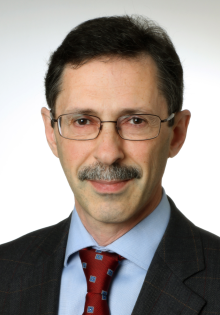New system to supply buildings with electricity, heat, cold and fresh air
By 2050, almost all private and public buildings in Germany should be "climate neutral" - that is the Federal Government's ambitious goal. The plan: In 30 years, residential buildings, office buildings, etc. will consume significantly less energy than today, and greenhouse gas emissions that are harmful to the climate will hardly be released when generating electricity, heat and cold for buildings. For this purpose, buildings are to be renovated in terms of energy, equipped with new plant technology and supplied predominantly from renewable energies. Scientists at the University of Paderborn want to play a role as part of a new research project. Under the leadership of the project coordinator Bavarian Centre for Applied Energy Research, together with seven other industrial companies, they are developing a system that supplies buildings with electricity, heat, cold and fresh air at the same time is energy efficient and relies entirely on renewable energies. The four-year project is funded by the Federal Ministry for Economic Affairs and Energy with around three million euros.
“Previous research projects have focused on systems that can only generate electricity and heat for buildings. In our research project, we are developing a combined system that for the first time supplies all houses and public buildings with energy - in other words, produces electricity and heat, but also cold and fresh air for heating, cooling and ventilation,”explains Prof. Dr. Eugeny Kenig, who is in charge of the project, together with his research assistant Matti Grabo, M.Sc and KET Managing Director, Dipl. Wirt.-Ing. Gerrit Sonnenrein. He is also Chair of Fluid Process Engineering and Chairman of the Board of Competence for Sustainable Energy Technology (KET), a central scientific institution of the university.
Solar power and environmental cold make it possible
The planned supply system is based entirely on renewable energies: The central component is a photovoltaic thermal collector (PVT), which can be installed on roofs and facades of houses. The PVT collector can generate electricity, heating and cooling using solar power, solar heat and environmental cooling. "During the day, the system converts solar energy into electricity and heat and at night it uses environmental cooling - essentially by exchanging radiation with the cold night sky," explains Gerrit Sonnenrein. A heat pump, also integrated into the system, ensures that the temperatures reached in the building can be raised or lowered as required. Heat and cold storage bridges any deficiencies absent between energy generation and demand. A ventilation system with heat recovery completes the system.
Since it is supplied exclusively from renewable energies, the overall system could play an important role in energy supply in the future: While electricity in Germany is already largely generated from renewable energy sources such as wind power, there are still systems behind our heating and hot water supply, which are mainly operated with natural gas and oil – leading to climate-damaging greenhouse gas emissions. The new system could reduce this "regenerative gap" in heat supply.
Energy saving, reducing costs and relieving the grid
But not only that, the new supply system should be highly energy efficient: “The coordinated components of the system will ensure that it works efficiently. That means: With the lowest possible energy consumption, the system will make optimal use of the self-generated regenerative energy and extensively cover the user's own needs - for example with electricity and heat, ”says Matti Grabo. And: companies, public institutions and private individuals could save money in the future with the modern efficient supply system, because it would reduce energy consumption in the areas of heating and cooling. "The intelligent control and use of innovative storage in our system could also relieve the supply networks: Depending on the energy requirements of a building, they ensure that, for example, excess electricity from public networks is used," commented Gerrit Sonnenrein.
Intelligent control with integrated weather forecast models
The supply system with the PVT collector, heat pump and Co. should be operated via a central control unit. Matti Grabo adds: “The control unit will contain operation, regulation, monitoring, visualization and energy management. In order for the system to work optimally in terms of energy, we will also integrate weather forecast models that enable predictive control of the system. ”
In order to make the KET system practicable as soon as possible, Grabo and Sonnenrein are working on a research project with experts from the construction industry, architects, heating, air conditioning, control and solar technicians as well as experts in thermal energy storage. Once the supply system has been developed, it will be tested on specific key buildings in an initial practical phase.
About the "Competence Centre for Sustainable Energy Technology" (KET) at the University of Paderborn
KET was founded against the background of climate protection and resource conservation of energy sources. Scientists from the Faculty of Mechanical Engineering and the Faculty of Electrical Engineering, Computer Science and Mathematics work together here. Their common goal: to advance interdisciplinary research in the fields of innovative energy generation and efficient and environmentally friendly energy use.
Further information on the project: https://projektinfos.energiewendebauen.de/foerderkennzeichen/03en1009f/
Further information on the Competence Centre for Sustainable Energy Technology (KET): https://ket.uni-paderborn.de

![[Translate to English:] [Translate to English:]](/fileadmin-eim/_processed_/4/a/csm_csm_Portraitfoto_Kenig_0aae8c9ab1_361ca27cfc.jpg)
![[Translate to English:] [Translate to English:]](/fileadmin-eim/_processed_/7/4/csm_csm_Portraifoto_Grabo_c14ec59f93_9974d4bec3.jpg)
![[Translate to English:] [Translate to English:]](/fileadmin-eim/fakultaet/News/EIM20/Portraitfoto_Sonnenrein.png)
